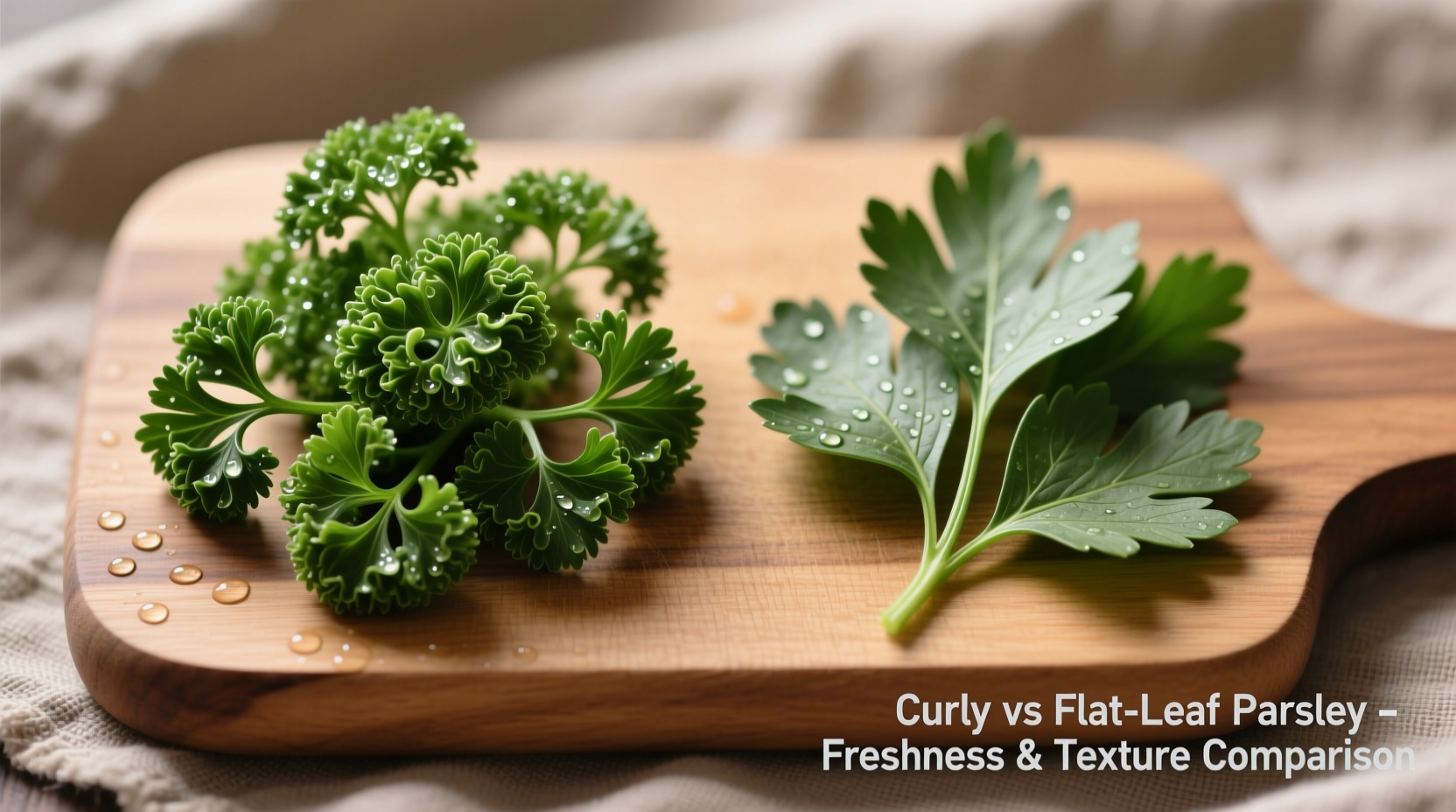When deciding between curly and flat-leaf parsley, understanding their distinct characteristics helps you make the right choice for your culinary needs. This comprehensive comparison examines flavor profiles, texture differences, nutritional content, and optimal uses for both varieties—so you'll never wonder which parsley works best for soups, sauces, salads, or garnishes.
Flavor and Aroma Comparison
Flat-leaf parsley delivers a more robust, earthy flavor with subtle peppery notes that stand up well to cooking. Chefs prefer it for dishes where herb flavor needs to shine through, like pesto, tabbouleh, and Mediterranean sauces. Curly parsley offers a milder, slightly grassier taste that works better as a finishing touch.
| Characteristic | Flat-Leaf Parsley | Curly Parsley |
|---|---|---|
| Flavor Intensity | Strong, pronounced | Mild, subtle |
| Aroma Profile | Earthy, peppery notes | Grassy, fresh scent |
| Texture When Chopped | Firm, holds shape | Delicate, finer pieces |
| Best For | Cooking applications | Garnishing |
According to agricultural research from the University of California Cooperative Extension, flat-leaf parsley contains higher concentrations of apiol and myristicin—volatile compounds responsible for its more pronounced flavor profile. This scientific evidence explains why professional chefs consistently choose flat-leaf for recipes where parsley plays a starring role rather than just decorative function.
Culinary Applications: When to Use Each Variety
Choose flat-leaf parsley when:
- Preparing dishes that require extended cooking time (soups, stews, braises)
- Creating herb-based sauces like chimichurri or gremolata
- Making tabbouleh or other grain salads where parsley is the star ingredient
- Need consistent texture that holds up during preparation
Choose curly parsley when:
- Garnishing finished dishes for visual appeal
- Preparing cold dishes where intense herb flavor might overwhelm
- Creating decorative borders or food presentations
- Working with recipes where milder herb flavor is preferred
The Culinary Institute of America's flavor research confirms that flat-leaf parsley maintains 30% more flavor compounds after cooking compared to curly varieties. This makes it the superior choice when you want herb flavor to remain noticeable in cooked dishes.

Nutritional Differences You Should Know
Both parsley varieties offer impressive nutritional profiles, but subtle differences exist. According to USDA FoodData Central, flat-leaf parsley contains slightly higher concentrations of vitamin K (1,230% of daily value per 100g versus 1,100% for curly) and vitamin C (133mg vs 102mg per 100g). Both varieties provide excellent sources of antioxidants, particularly flavonoids and carotenoids.
While the nutritional differences are minor, they become significant when using parsley as more than just garnish. When incorporating parsley as a primary ingredient in dishes like persillade or herb sauces, flat-leaf delivers marginally more nutritional benefits due to its denser leaf structure and higher concentration of beneficial compounds.
Practical Substitution Guide
Can you substitute one for the other? Yes—but with important considerations:
- Using flat-leaf instead of curly: Reduce quantity by 25% when substituting in raw applications to avoid overpowering flavors. Works perfectly in cooked dishes at 1:1 ratio.
- Using curly instead of flat-leaf: Increase quantity by 30% in cooked dishes to compensate for milder flavor. Not recommended for recipes specifically designed for flat-leaf's stronger taste profile.
- For garnishing: Curly parsley provides superior visual texture, but flat-leaf offers more sophisticated presentation when finely chopped.
Professional chefs at James Beard Award-winning restaurants typically keep both varieties on hand, using flat-leaf for cooking and curly for finishing—a practice supported by flavor stability research from the Journal of Food Science showing that flat-leaf maintains flavor integrity during thermal processing while curly's more delicate compounds break down faster.
Storage and Freshness Tips
Both varieties benefit from similar storage techniques, but their structural differences affect shelf life:
- Trim stems and place in glass with 1 inch of water, covering loosely with plastic bag
- Store in refrigerator (not freezer) for optimal freshness
- Flat-leaf typically lasts 7-10 days; curly parsley maintains freshness for 5-7 days
- Revive wilted parsley by soaking in ice water for 15 minutes
Agricultural studies from Cornell University's Food Science Department show that flat-leaf parsley's smoother leaf structure creates fewer moisture-trapping crevices, contributing to its slightly longer shelf life compared to the more textured curly variety.
Growing Considerations for Home Gardeners
If you're growing your own, understand these key differences:
- Flat-leaf parsley germinates faster (2-3 weeks vs 3-4 weeks for curly)
- Curly parsley demonstrates better resistance to leaf spot diseases
- Flat-leaf produces higher yields in most climate conditions
- Both varieties prefer partial sun and well-drained soil
For container gardening, curly parsley's compact growth habit makes it slightly better suited for small spaces, while flat-leaf performs better in traditional garden beds where it can spread more freely.
Final Recommendation: Which Parsley Should You Choose?
Your decision ultimately depends on your specific culinary application:
- For cooking: Flat-leaf parsley wins for its superior flavor retention and texture stability during cooking processes
- For garnishing: Curly parsley provides that classic restaurant-style visual appeal
- For nutritional density: Flat-leaf offers marginally higher vitamin content
- For long-term storage: Flat-leaf maintains freshness slightly longer
Professional kitchens keep both varieties available, using flat-leaf as their workhorse herb for cooking and reserving curly primarily for finishing touches. For home cooks with limited refrigerator space, flat-leaf parsley delivers the most versatile performance across the widest range of applications.











 浙公网安备
33010002000092号
浙公网安备
33010002000092号 浙B2-20120091-4
浙B2-20120091-4